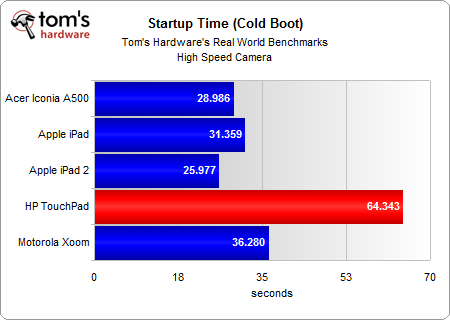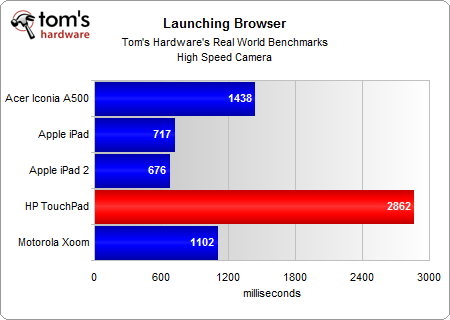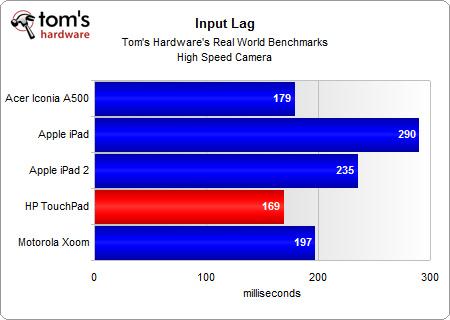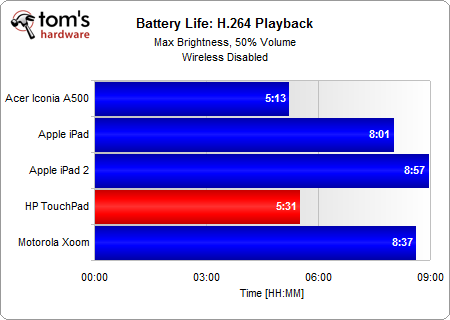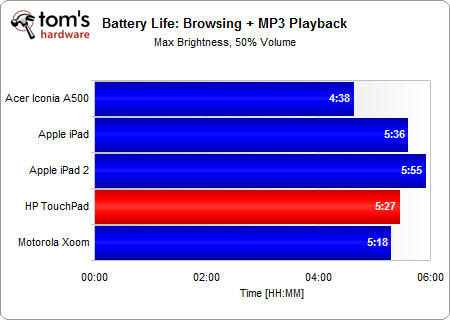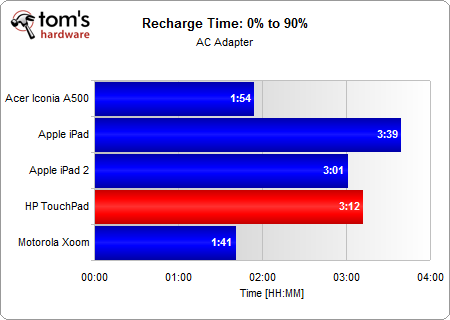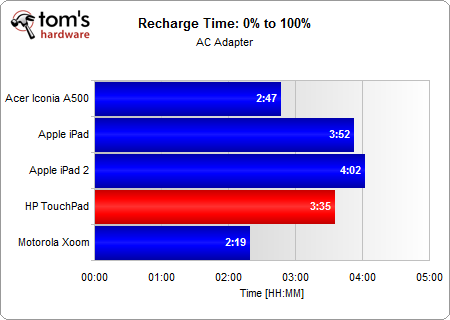HP TouchPad Review: A Tablet For Productivity?
Battery Life And Real-World Benchmarks
Real-World Benchmarks
Early on we discovered how difficult it is to benchmark tablets. Benchmarking responsiveness with a camera is the easiest approach.
Of course, normal cameras won't cut it, since they only shoot at 29 FPS. That's unacceptable if you're trying to measure precise time differences. Going the stop-watch route is no better due to human-introduced errors. That's why we're using a 1000 FPS high-speed camera to measure performance. Since, one frame equals one millisecond, it’s possible to measure timings with a high degree of accuracy.
Even though the TouchPad's third-gen Snapdragon employs a more refined processor design than its competition, the boot time measurement suggests that webOS 3.0.2 is a more bloated operating system.
This is confirmed by our browser launch time benchmark. Compared to the A500 and Xoom, it takes twice as long to open a browser window on the TouchPad. Apple's iPad 2 reigns king here with a much leaner operating system and browser. It doesn't even take a full second to launch Safari in iOS.
Input lag is the time it takes from pressing a key to the time it takes for text to appear on the screen. This tells you how fast a tablet is registering an action. Ideally, you want low input lag so that you don't feel like the tablet is stuttering as you type or click buttons. The average college student has a reaction time of 200 milliseconds for visual stimuli, so there's no perceivable lag while you're typing with the TouchPad.
Battery Life
Get Tom's Hardware's best news and in-depth reviews, straight to your inbox.
Testing a tablet’s battery life tends to be highly variable unless you control the entire experience from beginning to end. Cumulatively, touch gestures don’t have a great impact on battery life. The biggest factors are CPU/GPU processing, screen brightness, volume, and Wi-Fi use. In order to accurately measure battery life, I coded a script that automatically plays MP3s at 50% volume while browsing different Wikipedia pages every 12 minutes. This benchmark is probably overkill, but it gives you an idea of a worst-case scenario.
Recharge Time
Charging times are a double-edged sword. Ideally, you want a nice slow charge so that your battery lasts more than a few hundred cycles. Fast charge times keep you away from the wall socket longer, but in the long run they cut down on the health of the battery. Usually, the rate of charge starts to slow down somewhere in the 80% to 95% range, which is why the charging time from 0% to 10% is faster than 90% to 100%.
Current page: Battery Life And Real-World Benchmarks
Prev Page Display Quality: White And Black Uniformity Next Page Is The TouchPad An iPad Or Xoom Competitor?-
obarthelemy I have faith in the QuickOffice port coming through: datawiz have been woking in the mobile space since Palm days (actually, they started on Palm I think, so they know their stuff, and the platform. It works well on Android.Reply -
obarthelemy I don't understand why you use the Xoom as the Android yardstick though, it's been upstaged long ago, by the Asus and Samsung tablets at leastReply -
compton I'm certainly glad the TouchPad has a decent display -- a good trend to say the least. Apple deserves much of the credit for setting the quality bar in consumer devices like the iPhone/iPad. Happily, if you are looking around for a new phone or tablet, good displays are easy to find. If consumers as a whole get used to using good screens in tablets/phones, why don't more laptop manufacturers capitalize by upping their game? HP may have realized that the TouchPad needs a good display, but most laptop (theirs, Dell's, Asus, ect.) displays are shamefully terrible. Perhaps the laptop as we know it needs an injection of what makes modern tablets so appealing -- and at (or around) the top of that list is a bitchin' screen.Reply -
I've probably read at least 20 reviews of the touchpad. This is the only one I would actually call a review. This was balanced and in-depth. Thank you for your efforts.Reply
The one thing lacking in this review, which is also lacking in everything being written about webos, is the mention of what I consider one of the standout features of webos: The openness of the platform. With preware installed (free), you have access to thousands of patches and homebrewed apps as well as linux applications. It is possible, for example, to run a full Debian Linux in a chrooted environment (without any cracking or jailbreaking), giving access to OpenOffice, and all other x-server Linux software out there. HP/Palm is the only tablet OS developer that actively encourages the homebrew/open source community in its efforts. As a developer, it is not only the ease of development that is compelling but the huge amount of expressive and creative freedom you get. With the Apple appstore, the walled garden may protect consumers well, but also creates a completely controlled and often repressive and capricious environment for a developer. This openness is the secret sauce behind much of the loyalty of webos users. The os is a joy to use, a joy to explore, and a joy to create new code in. And unfortunately, most reviewers can't or won't take the time to understand this extremely compelling aspect of the OS.
Thank you again for the best review of the touchpad I've seen yet. -
Well done review!...most thorough and in-depth of any I've seen thus far. As a user of about 3 weeks, I learned several new things I'd not discovered before. I second klktrk's comment about the homebrew community at PreCentral. I've taken advantage of several patches to customize my TouchPad (overclocking to 1.5 GHz, increased volume setting, etc)Reply
-
HP really invested a lot of time and effort going into this tablet, and it is most definitely going to be an Apple killer and an Android killer one day. The potential it has is remarkable. Maybe not in this model, but in the next. As for right now, the card system in ingenious, the notification system is perfect, wireless charging is perfect, tap to share is perfect, and many many other things, including it's up to par with Apples A5 processor chip and Android Nvidia Tegra 2 Duo Core processor that evens out the fact that all these tablets are roughly the same speed, except for Apple, who lacks flash content support browser-wise. HP really leveled the playing field on this one, especially with the HD screen, and the Beats Audio, And also with their immense advertising. I don't know about you guys but I see the TouchPad on a lot of commercials and on ads everywhere! I'm thinking about buying one for school instead of the regular laptop.Reply
-
absoluthunter LED Pixels? Pretty sure this is an S-IPS LCD screen with LED back light. Sure wish people would understand the difference, specially when reviewing in technical forums.Reply -
BlueFireAngel Thanks for a solid review! I'm not a Palm/HP owner yet but I hope to be someday soon. I've been impressed with Palm since I got a PDA 10 years ago. And since I've seen the Palm Pre I've been excited about the potential of webOS. I hope it catches on and that people begin to realize how powerful a tool webOS can become.Reply
Thanks again, Andrew! -
Honis Very nice review.Reply
HP just announced the $100 off sale from this last weekend is now permanent.
"Effective immediately, the HP TouchPad 16GB Wi-Fi will now be available for $399.99 and the HP TouchPad 32GB Wi-Fi will now be available for $499.99"
http://vdccnz2prof.houston.hp.com/view_email.asp?eid=10048010&mid=055f0aa5-75fa-414f-9913-9aa980bb0ef7
